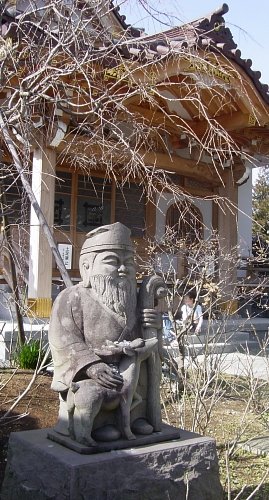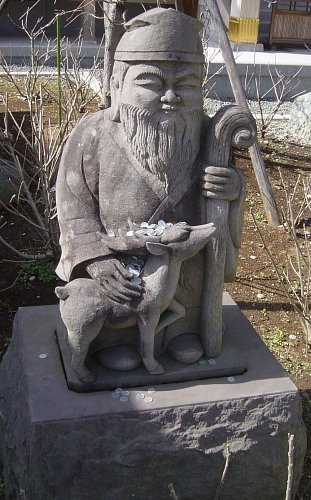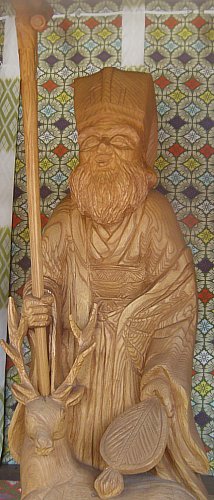|
|
|
|

JURŌJIN, JUROJIN, JUROUJIN
God of Wisdom and Longevity
Ju 寿 = Longevity, Rō 老 = Old, Jin 人 = Person
Origin = Chinese TaoismOne of Japan’s Seven Lucky Gods
Animal Associations = Deer, Tortoise, Crane, Stag Associated Virtue = Longevity
|
SEVEN VIRTUES
Japan's Seven Lucky Gods are a popular grouping of deities
that appeared from the 15th century onward. The members of
the grouping changed over time, but a standardized set
appeared by the 17th century. In the 17th century, Japanese
monk Tenkai (who died in 1643 and was posthumously named
Jigen Daishi) symbolized each of the seven with an essential
virtue for the Shogun Tokugawa Iemitsu (1623-1650 AD).
The seven virtues are:
- Candour (Ebisu)
- Fortune (Daikokuten)
- Amiability (Benzaiten)
- Magnanimity (Hotei)
- Popularity (Fukurokuju)
- Longevity (Juroujin)
- Dignity (Bishamonten)
References: Flammarion Iconographic Guide - Buddhism
|
Male. God of Wisdom. Jurōjin 寿老人 is a deity from China’s Taoist pantheon. Described as a Chinese sennin 仙人 (immortal), Jurōjin is also a personification of the southern polar star (Jp. = Nankyokusei 南極星). He is depicted in legends as a great lover of wine and fond of female company. Commonly shown as an old man with a long white beard carrying a knobbly staff with a scroll tied to it, on which is written the life span of all living things or, in other accounts, a record of all the good and bad deeds committed by all beings <Chiba, pp 35-38>, or the book of knowledge <Flammarion, p. 240>. The deer, a symbol of longevity, typically accompanies him as a messenger, as do other long-lived animals such as the stag, crane, or tortoise. Jurōjin is often confused with Fukurokuju (another Taoist deity who is likewise a member of the Seven Lucky Gods). The two are said to inhabit the same body, hence the confusion. <Source: Butsuzō-zu-i>.
|

Jurōjin, the god of wisdom and longevity,
at Myōryūji Temple 妙隆寺 in Kamakura.
Myōryūji Temple is also one of seven sites on
the Kamakura Pilgrimage to the Seven Gods.
|

Jurōjin, the god of wisdom and longevity,
at Myōryūji Temple 妙隆寺 in Kamakura.
Myōryūji Temple is also one of seven sites on
the Kamakura Pilgrimage to the Seven Gods.
|
|
MORE ABOUT JURŌJIN
|
|

|

Jurōjin holding scroll of life,
accompanied by long-lived deer
Jurōjin is the god of wisdom and longevity.
Myōryūji Temple 妙隆寺 in Kamakura.
Myōryūji Temple is one of seven sites on
the Kamakura Pilgrimage to the Seven Gods.
|
Says Butsuzō-zu-i 仏像図彙: “A god representing the three other stars 三星 of the Southern Cross, all rolled into one. When considered an amalgamation of the 福星 (wealth star), 録星 (happiness star), and 寿星 (longevity star), he appears with the crane or tortoise and brings the gift of longevity to devotees. Jurōjin & Fukurokuju are the same deity.” Editor’s Note: The three stars spell 福録寿, aka Fukurokuju, the god of Wealth, Happiness, & Longevity.
|
|
|
|
 Says JAANUS: 寿老人. Japanese = Jurōjin; Chinese = Shoulaoren. A Chinese Taoist god known as the immortal of the Northern Song 北宋 and also considered the personification of the southern polar star (Jp. = Nankyokusei 南極星). In Japan he became a popular god of longevity and one of the "Seven Gods of Good Fortune" (Shichifukujin 七福神). The legendary Jurōjin is said to be based on an actual person alive in the late 11th century, who stood nearly three shaku 尺 (roughly six feet) in height and possessed an elongated head [editor = but not as elongated as Fukurokuju]. Besides the distinctive cranium, he is represented in painting with a white beard, carrying a round fan and staff with a sutra hanging from it. Often he is accompanied by a crane or a white stag said to be 1,500 years old. He is also often shown under another symbol of longevity, the plum tree. Of the many Japanese paintings of Jurōjin, those by Sesshuu 雪舟 (1420-1506), Sesson Shuukei 雪村周継 (1504?-90?), Kanou Tan'yuu 狩野探幽 (1602-74) and Maruyama Oukyo 円山応挙 (1733-95) are best known. <end JAANUS quote> Says JAANUS: 寿老人. Japanese = Jurōjin; Chinese = Shoulaoren. A Chinese Taoist god known as the immortal of the Northern Song 北宋 and also considered the personification of the southern polar star (Jp. = Nankyokusei 南極星). In Japan he became a popular god of longevity and one of the "Seven Gods of Good Fortune" (Shichifukujin 七福神). The legendary Jurōjin is said to be based on an actual person alive in the late 11th century, who stood nearly three shaku 尺 (roughly six feet) in height and possessed an elongated head [editor = but not as elongated as Fukurokuju]. Besides the distinctive cranium, he is represented in painting with a white beard, carrying a round fan and staff with a sutra hanging from it. Often he is accompanied by a crane or a white stag said to be 1,500 years old. He is also often shown under another symbol of longevity, the plum tree. Of the many Japanese paintings of Jurōjin, those by Sesshuu 雪舟 (1420-1506), Sesson Shuukei 雪村周継 (1504?-90?), Kanou Tan'yuu 狩野探幽 (1602-74) and Maruyama Oukyo 円山応挙 (1733-95) are best known. <end JAANUS quote>
Says the Flammarion Iconographic Guide: Jurōjin is the god of good luck and longevity. He is very probably of the same origin as his godfather Fukurokuju, with whom he is often confused. Thought to be a great lover of rice wine (sake), he is represented as a small old man with a wide forehead (but narrower than that of Fukurokuju), holding a knobbly staff in the hand, to which the book of knowledge is attached. He is accompanied by a crane, a black deer, or a tortoise. He is sometimes called Rōjinseishi (in Japan) when identified with the Chinese sage Laozi. <end Flammarion quote>
Editor’s Note: Laozi, Laozu, Lao-tsu, Rōshi, or Laocius, the founder and "old boy" of Chinese Taoism. Pronounced Rōjin 老人 (Rojin, Roujin) in Japan.
Chiba Reiko, author of The Seven Lucky Gods of Japan (1966): Her book says both Jurōjin and Fukurokuju are often depicted in artwork accompanied by a deer, and are thus easily confused. However, Jurōjin’s deer is typically black in color. In China, she says, deer are considered wise, and the older they become, the wiser they become. This is depicted in artwork by color -- a 1000-year-old deer is blue, a 1500-year-old deer is white, and a 2000-year-old deer is black. She also says that devotees who offer Jurōjin a drink are rewarded by Jurōjin, who taps his head and gives them part of his wisdom. Chiba relates a story about Jurōjin’s love of alcohol. He was once invited to a feast given by the emperor, and told he could drink as much wine as he desired. According to this Chinese tale, he consumed one koku (nearly 40 gallons of wine) that night, but was completely sober the next day when he presented himself to the emperor to offer thanks. He prophesied a long and golden reign for the emperor, and then disappeared in a puff of white mist.
|
|
SOURCES
|
|
- Butsuzō zui 仏像図彙 (Illustrated Compendium of Buddhist Images). Published in 1690 (Genroku 元禄 3). A major Japanese dictionary of Buddhist iconography. Hundreds of black-and-white drawings, with deities classified into categories based on function and attributes. For an extant copy from 1690, visit the Tokyo Metropolitan Central Library. An expanded version, known as the Zōho Shoshū Butsuzō-zui 増補諸宗仏像図彙 (Enlarged Edition Encompassing Various Sects of the Illustrated Compendium of Buddhist Images), was published in 1783. View a digitized version (1796 reprint of the 1783 edition) at the Ehime University Library. Modern-day reprints of the expanded 1886 Meiji-era version, with commentary by Ito Takemi (b. 1927), are also available at this online store (J-site). In addition, see Buddhist Iconography in the Butsuzō-zui of Hidenobu (1783 enlarged version), translated into English by Anita Khanna, Jawaharlal Nehru University, New Delhi, 2010.
- JAANUS. Japanese Architecture and Art Net Users System. A wonderful online dictionary compiled by the late Dr. Mary Neighbour Parent. It covers both Buddhist and Shinto deities in great detail. Over 8,000 entries. Written in English, yet presenting all key terms in Japanese.
- Buddhism (Flammarion Iconographic Guides)
 , by Louis Frederic, Printed in France, ISBN 2-08013-558-9, First published 1995. A highly illustrated volume, with special significance to those studying Japanese Buddhist iconography. Includes many of the myths and legends of mainland Asia as well, but its special strength is in its coverage of the Japanese tradition. Hundreds of accompanying images/photos, both B&W and color. Frederic uses many images from the Butsuzō zui (see prior entry) , by Louis Frederic, Printed in France, ISBN 2-08013-558-9, First published 1995. A highly illustrated volume, with special significance to those studying Japanese Buddhist iconography. Includes many of the myths and legends of mainland Asia as well, but its special strength is in its coverage of the Japanese tradition. Hundreds of accompanying images/photos, both B&W and color. Frederic uses many images from the Butsuzō zui (see prior entry)
- Essentials of Buddhist Images: A Comprehensive Guide to Sculpture, Painting, and Symbolism. By Kodo Matsunami. Paperback; first English edition March 2005; published by Omega-Com. Matsunami (born 1933) is a Jōdo-sect 浄土 monk, a professor at Ueno Gakuen University, and chairperson of the Japan Buddhist Federation. He received the government's Medal of Honor (褒章 hōshō), Blue Ribbon, for his achievements in public service. Says Matsunami: “Bishamonten protects from disaster and bodily harm. Daikoku satisfies the deisre for food. Benzaiten represents sexual desire. Hotei brings laughter, and Ebisu grants wealth.
- Tobifudo Deity Dictionary. Ryūkozan Shōbō-in Temple 龍光山正寶院 (Tokyo). Tendai Sect. Jump to its Jurojin page.
- The Seven Lucky Gods of Japan
 , by Chiba Reiko. Charles E. Tuttle Co., 1966. Pages 35-38. , by Chiba Reiko. Charles E. Tuttle Co., 1966. Pages 35-38.
- UCLA Center for East Asian Studies, Educational Resources from teacher Samantha Wohl, Palms Middle School, Summer 2000. See Wohl’s Materials List (based on Chiba Reiko’s book).
LEARN MORE
This is a side page
Return to Seven Lucky Gods Main Page

|
|